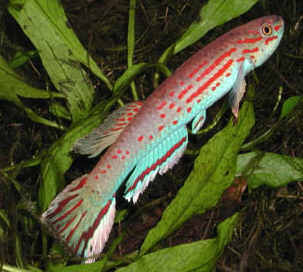Aphyosemion pascheni festivum (Amiet 1987)

HLM 99 / 23 Photo courtesy of Vasco Gomes
| Meaning of Name |
Refers to the bright or festive colours of the species, particularly the caudal fin. |
|||
| First Description |
Amiet J.L 1987. Fauna of Cameroon Vol 2. The genus Aphyosemion Myers (Pisces: Teleostei, Cyprinodontiformes). Scieces Naturales, Compiegne. p 262. Includes plates, maps, line drawings & figures. |
|||
| Size |
49 mm (Amiet 1987) |
|||
| Meristics |
D = 11-14, A = 14-15, D/A = +5-6, ll = 29-30 (Amiet 1987) |
|||
| Karyotype |
|
|||
| Sub-Genus |
Mesoaphyosemion |
|||
| Group |
calliurum |
|||
| Synonyms |
None |
|||
Populations
|
http://www.nakashima.org/gaphyosemion_pascheni_festivum.htm Japan Gallery |
|||
| Type Locality |
10 km southeast of Kribi in the direction of Nyété, Elephant Hill. |
|||
| Distribution |
Restricted to the type locality. A geographic barrier exists between the two subspecies. |
|||
| Habitat |
Collected about 10 km south of the known distribution area of A.pascheni south of Longji at Elephant Hill. All streams in this area flow into the Lobe River. |
|||
| Distinguishing Characteristics | Distinguished
from A.pascheni pascheni by being
generally brighter coloured. The caudal has a flared pattern centrally.
Spots of red forming lines on the front half of the body are heavy. Pectoral
fins are practically clear unlike A.pascheni
pascheni which are patterned by a marginal band of feint yellow
& a sub marginal band of feint red. Top outer margin to caudal fin is wider. Front part of body has heavier horizontal lines. |
|||
| Colour/Pattern Variability | ||||
| History |
First collected by Amiet in 1985 & described by him in 1987. |
|||
| Breeding Notes |
Bob Merrit gave a report in BKA newsletter No. 456, Sept.2003. Rainwater was used for breeding. Over a 2 week period 22 eggs were collected on a sample of Java moss. These were picked off into another container & floated in the tank. Most eggs hatched at 75°F in 20 days. Fry were fed newly hatched brine shrimp as a first food. |
|||
| Diameter of Egg | ||||
| Remarks |
For sale in limited numbers at BKA auctions 2000. |